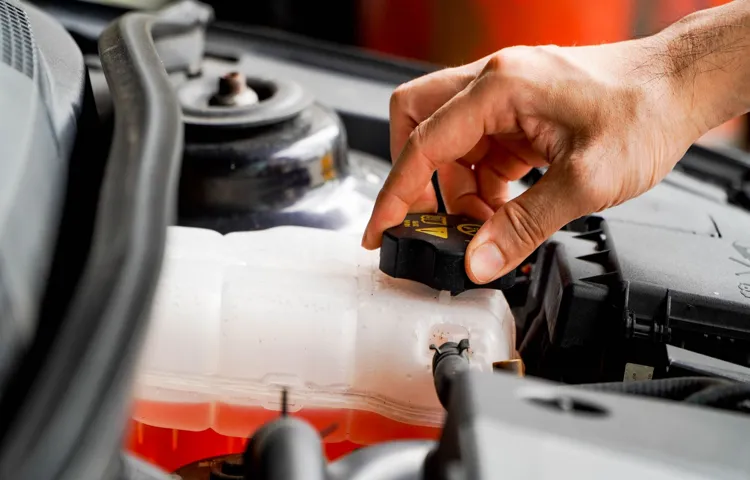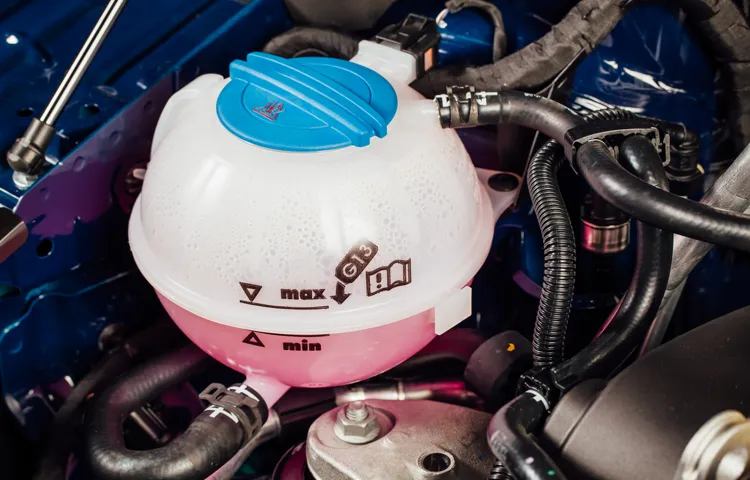If you’re a car owner, chances are you’ve heard of the importance of a coolant reservoir tank. It helps to maintain the appropriate level of coolant in your engine and prevents damage from overheating. But what do you know about coolant reservoir tank pricing? It’s easy to overlook the cost of this important component when considering the overall expenses of vehicle maintenance.
However, understanding coolant reservoir tank pricing can help you make informed decisions and keep your car running smoothly without breaking the bank. In this blog, we’ll dive into the various factors that impact the cost of coolant reservoir tanks, including material and brand. We’ll also discuss how to determine if it’s time to replace your coolant reservoir tank and how to calculate the overall cost of replacement.
Don’t let the cost of a coolant reservoir tank catch you off guard. Read on to learn everything you need to know about coolant reservoir tank pricing and how to make the best choices for your vehicle and your wallet.
Table of Contents
Basics of Coolant Reservoir Tanks
If you’re wondering how much a coolant reservoir tank costs, it depends on the make and model of your car. Typically, OEM (Original Equipment Manufacturer) coolant reservoir tanks can cost anywhere from $70 to $200, while aftermarket options can be slightly cheaper. But why is a coolant reservoir tank important anyways? Well, it serves as a reservoir for excess coolant that expands as your engine heats up.
As the coolant expands, it flows into the tank, and when the engine cools down, it is sucked back into the system. Without a properly functioning coolant reservoir tank, your engine could overheat and cause serious damage. But don’t worry, if you need to replace your coolant reservoir tank, it’s generally a simple and affordable fix that can save you from much bigger problems down the road.
What is a Coolant Reservoir Tank?
A coolant reservoir tank is a crucial component of a vehicle’s cooling system. It serves as a storage area for excess coolant that may expand due to the increased temperature of the engine. Once the engine cools down, the coolant is then drawn back into the radiator for reuse.
This continual cycle keeps the engine running at an optimal temperature. The coolant reservoir tank is typically made of plastic and is transparent, allowing quick and easy visual inspection of coolant levels. A malfunctioning coolant reservoir tank can result in low coolant levels, leading to engine overheating, which can cause significant damage.
It’s essential to routinely check the coolant levels in the reservoir tank and keep it filled with the correct type of coolant recommended by the manufacturer. By doing so, the engine’s cooling system will remain in good working condition and help prevent costly repairs down the line.

Why it is Important for Your Car?
Coolant reservoir tanks are a crucial part of your car’s engine, helping to regulate its temperature and keep it running smoothly. Coolant, also known as antifreeze, is a mixture of water and chemicals that keeps the engine from overheating. The reservoir tank is where the coolant is stored when it is not being circulated through the engine.
It allows for expansion and contraction of the coolant as the engine heats up and cools down, ensuring that the right amount of coolant is always available. Without a functioning coolant reservoir tank, your car’s engine could overheat and cause serious damage, such as a blown head gasket or seized engine. Not only is this costly to repair, but it could also put you and your passengers in danger if the engine fails while you are driving.
To ensure that your coolant reservoir tank is working properly, it’s important to regularly check the level of coolant and look for any signs of leaks or damage. If you notice that your car is running hot or that the engine temperature gauge is rising, it is possible that the coolant reservoir tank is not functioning correctly. In this case, it’s important to have your car serviced by a professional mechanic as soon as possible.
Overall, the importance of a coolant reservoir tank cannot be overstated when it comes to the health and safety of your car. By ensuring that this key component is functioning properly, you can help to keep your engine running smoothly and avoid costly repairs down the line.
Factors that Affect Coolant Reservoir Tank Pricing
When it comes to replacing a coolant reservoir tank, the price can vary depending on several factors. Some of the factors that impact the pricing include the make and model of your vehicle, the manufacturer of the tank, and the supplier you’re purchasing from. A genuine OEM (Original Equipment Manufacturer) coolant reservoir tank will generally cost more than a third-party tank.
Additionally, the size of the reservoir tank and the materials used to manufacture it can also affect the price. It’s important to do your research before purchasing a coolant reservoir tank to ensure you’re getting the best value for your money. In summary, the cost of a coolant reservoir tank can range anywhere from $50 to $200 depending on the above factors, with the average cost falling around $100.
Make and Model of Your Car
When it comes to purchasing a coolant reservoir tank, there are a variety of factors that can affect the price point you can expect to pay. Some of the key considerations include the make and model of your car, the material used in the tank construction, and the size of the container you need. In particular, the make and model of your car can have a significant impact on the cost of your coolant reservoir tank.
If you own a luxury or high-end vehicle, you may need a specialized component that is only available through the dealership, which can drive up the cost. Additionally, certain car models may have more complex or intricate cooling systems that require more advanced or specialized components. By understanding these factors and considering them carefully, you can make an informed decision about the best coolant reservoir tank for your specific needs and budget.
Location of Purchase
When it comes to purchasing a coolant reservoir tank, there are several factors that can affect the price of the product. One such factor is the location of purchase. Different areas may have varying levels of demand, supply, and cost of living, which can all impact the price of the tank.
For example, a coolant reservoir tank purchased in a more urban area may be more expensive than one purchased in a rural area due to higher overhead costs for the seller. Additionally, purchasing from a specialty auto parts store may be more expensive than purchasing from a generic retailer due to the expertise and specialized products offered. It’s important to consider the location of purchase when shopping for a coolant reservoir tank and to compare prices from different retailers to ensure you’re getting the best deal possible.
Brand and Quality
When it comes to coolant reservoir tank pricing, there are several factors that determine their cost. One of the most critical factors is the brand. High-end brands typically have higher prices than lesser-known brands because they invest in quality materials and testing to ensure that their products withstand extended use.
Additionally, these brands have established a reputation for their durability and reliability, which means that buyers are prepared to pay a premium for the extra peace of mind. Another crucial factor is the quality of materials used in manufacturing. Materials affect the overall performance and longevity of the tank, and high-quality materials often result in a higher price tag.
That said, the quality of the materials used should match the intended use of the reservoir tank. Finally, other factors like size, design, and functionality also play a part in determining reservoir tank prices. In summary, brands and materials are the two most significant contributors to the price of a coolant reservoir tank.
Average Cost of Coolant Reservoir Tanks
If you’re wondering how much a coolant reservoir tank costs, the answer is that it varies depending on your vehicle’s make and model. However, the average cost of coolant reservoir tanks falls between $50 and $150. These tanks, also known as overflow tanks or recovery tanks, play an essential role in keeping your engine cool and running smoothly.
The coolant reservoir tank collects excess coolant from the engine and releases it back into the system when the engine cools down. Over time, the tank may develop cracks or leaks and may need to be replaced. To avoid engine overheating and potential damages, it’s crucial to replace a faulty reservoir tank as soon as possible.
It’s essential to consult with a certified mechanic or automotive specialist to ensure that you’re choosing the right coolant reservoir tank for your vehicle.
Examples of Pricing for Different Car Types
When it comes to replacing a coolant reservoir tank in your car, the cost can vary depending on the make and model of your vehicle. Generally, the average cost for a new coolant reservoir tank can range from $50 to $150, with some luxury or specialty vehicles requiring a higher price point. For example, a new coolant reservoir tank for a Toyota Corolla may cost around $60, while a Mercedes-Benz C-Class could require a replacement tank costing upwards of $150.
It’s important to note that the cost of labor for installation is not included in these prices, so it’s important to factor that into your budget as well. Overall, it’s always a good idea to shop around and compare prices from different mechanics or auto parts stores to ensure you are getting the best value for your money.
Additional Costs to Consider
If you’re in need of a new coolant reservoir tank, it’s important to consider the cost. Prices can vary based on the make and model of your vehicle, but on average, you can expect to pay around $100 to $150 for a replacement tank. However, there are some additional costs to consider when replacing this component.
First, you’ll need to factor in the cost of any necessary tools or equipment to install the new tank. Additionally, you may need to pay for labor if you’re not comfortable doing the installation yourself. Depending on the mechanics in your area, this could add an additional $50-$100 or more to the total cost.
It’s also worth noting that if you’re replacing the coolant reservoir tank, it’s a good idea to replace the coolant as well. This is because the coolant may have been contaminated by the old tank, which can impact the performance of your vehicle. Overall, the cost of a replacement coolant reservoir tank can add up quickly, so it’s important to be prepared for any additional expenses that may arise.
Where to Shop for Coolant Reservoir Tanks
Looking for the best place to shop for a coolant reservoir tank? Well, you’ve come to the right spot. When searching for this item, you can typically expect to spend anywhere from $50 to $150. However, it’s always a good idea to shop around and compare prices from a few different retailers to ensure you’re getting the best deal possible.
Some great options for purchasing coolant reservoir tanks include auto parts stores such as AutoZone or Pep Boys, online marketplaces like Amazon or Ebay, and even car dealerships. Additionally, it’s important to note that not all coolant reservoir tanks are created equal, so be sure to read reviews and check the specifications before making your purchase. With a little research, you’ll be able to find the perfect coolant reservoir tank at an affordable price in no time.
Suggestions on Where to Look
Coolant reservoir tank When it comes to shopping for coolant reservoir tanks, one of the best places to begin your search is online. There are several reputable retailers that offer a wide variety of coolant reservoir tanks to choose from. Check out larger online marketplaces, such as Amazon or eBay, for a broader selection.
You can also visit the websites of auto parts stores, such as Advance Auto Parts, AutoZone, and O’Reilly’s, to see if they have the specific coolant reservoir tank you need. If you prefer to shop in person, local auto parts stores may have what you’re looking for as well. Don’t forget to check automotive specialty stores or mechanic supply shops, too.
These stores often carry rare and unique parts that you may not find elsewhere. Always make sure to double-check the make and model of your vehicle to ensure compatibility with the coolant reservoir tank you’re considering.
Tips for Finding the Best Deal
When it comes to finding the best deals on coolant reservoir tanks, the key is to shop at the right places. While you can certainly find them at your local auto parts store, you may end up paying more than you need to. Instead, consider shopping online through reputable retailers that specialize in automotive parts.
Websites like Amazon, eBay, and RockAuto offer great deals on a wide range of coolant reservoir tanks from various manufacturers. Plus, you can easily compare prices and reviews from other customers to ensure you’re getting the best product for your money. So, next time you’re in the market for a coolant reservoir tank, skip the trip to your local store and check out these online options!
Conclusion
In conclusion, the price of a coolant reservoir tank can vary depending on a multitude of factors such as the make and model of your vehicle, geographical location, and the complexity of the installation process. Like any car part, it’s essential to invest in a quality reservoir tank to ensure your engine runs smoothly and stays cool under pressure. So remember, while it may be tempting to penny-pinch on car repairs, a malfunctioning coolant reservoir tank could potentially lead to costly engine damage.
Invest wisely and keep your cool.”
FAQs
What is a coolant reservoir tank?
A coolant reservoir tank is a component in your vehicle’s cooling system that holds excess coolant as it expands due to heat.
How does a coolant reservoir tank work?
The coolant reservoir tank has a small opening that allows for the expansion and contraction of the coolant fluid as the engine heats up and cools down. It also acts as a way for you to visually check the coolant fluid level in your vehicle.
How do I know if my coolant reservoir tank is empty?
You can check the coolant level in the reservoir tank by looking at the markings on the side of the tank. If the fluid level is below the “minimum” marking, you may need to add more coolant.
Can a cracked coolant reservoir tank cause problems?
Yes, a cracked coolant reservoir tank can cause coolant to leak out of the system, leading to engine overheating. It is important to replace a cracked or damaged reservoir tank as soon as possible.
How often should I check my coolant reservoir tank?
It is recommended that you check your coolant reservoir tank at least once a month. This will help you catch any potential leaks or low coolant levels before they cause damage to your vehicle.
What type of coolant should I use in my reservoir tank?
Consult your vehicle’s owner’s manual or a mechanic to determine the type of coolant that is recommended for your vehicle. Using the wrong type of coolant can cause damage to your engine.
How much does it cost to replace a coolant reservoir tank?
The cost to replace a coolant reservoir tank can vary depending on the make and model of your vehicle and where you go for the replacement. On average, you can expect to pay between $50 and $200 for a new reservoir tank and installation.



